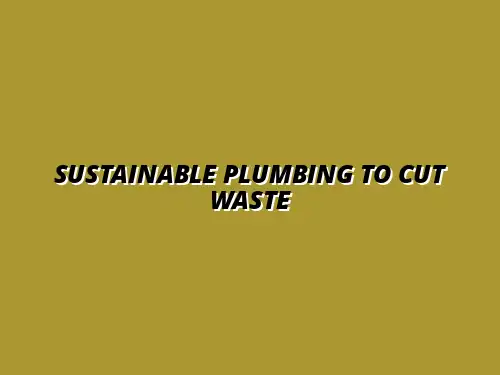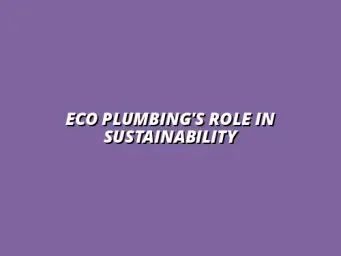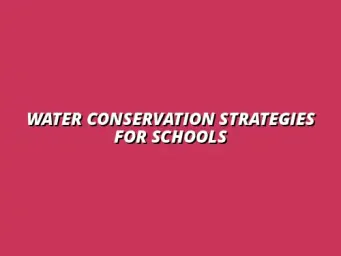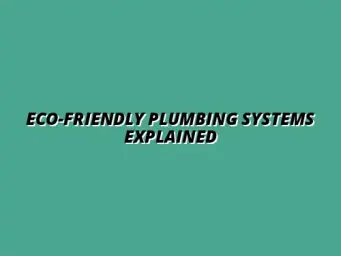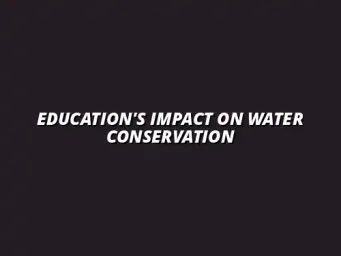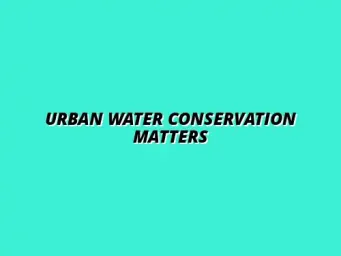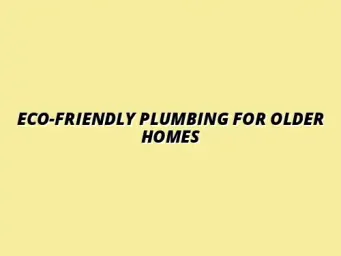Understanding Sustainable Plumbing Practices and Their Importance
Sustainable plumbing practices play a crucial role in building a more eco-friendly world. By utilizing methods and materials that save water and reduce waste, we can significantly lessen our environmental impact. Understanding these practices highlights their importance in conserving natural resources and promoting a healthier planet for future generations.
In essence, sustainable plumbing focuses on minimizing water usage while maintaining the efficiency of plumbing systems. This can involve everything from installing high-efficiency fixtures to adopting innovative water-saving technologies. It’s about being mindful of our resources and making choices that are beneficial for both our homes and the environment. For practical tips on reducing your daily water waste, check out these water-saving tips for your home.
Defining Sustainable Plumbing Practices
Sustainable plumbing practices can be defined as methods that prioritize water conservation and environmental protection. These practices not only aim to save water but also focus on reducing the energy consumption associated with heating water. Ultimately, they promote a harmonious relationship between our daily needs and the health of our planet.
When we talk about sustainable plumbing, it encompasses various strategies that can be implemented in residential and commercial settings. This includes the selection of eco-friendly materials, energy-efficient appliances, and innovative systems designed for water reuse. By understanding these practices, we can make informed decisions that lead to long-lasting benefits. Learn more about the benefits of eco-friendly plumbing for your home.
Key Characteristics of Sustainable Plumbing
There are several key characteristics that define sustainable plumbing practices. Here are some important features to consider:
- Water Efficiency: Focus on using less water without compromising performance.
- Energy Conservation: Minimize energy consumption associated with heating water.
- Durability: Use materials that last longer and require less frequent replacement.
- Waste Reduction: Implement systems that recycle or repurpose water.
These characteristics help ensure that plumbing systems are not only effective but also environmentally friendly. By prioritizing these features, we can create a more sustainable approach to our plumbing needs.
Overview of Eco-Friendly Plumbing Technologies
Eco-friendly plumbing technologies have evolved significantly in recent years. These advancements offer homeowners effective solutions for reducing water consumption and enhancing energy efficiency. Some notable technologies include:
- Low-flow fixtures: Faucets, showerheads, and toilets designed to use less water.
- Tankless water heaters: Provide hot water on demand, reducing energy waste. Maintaining your water heater efficiently is key; find out how here.
- Solar water heating systems: Utilize renewable energy to heat water.
- Rainwater harvesting systems: Collect and store rainwater for non-potable uses.
By integrating these technologies into our plumbing systems, we can make a significant impact in our efforts to conserve water and reduce energy consumption. Adopting such innovations not only benefits our homes but also contributes to a healthier environment.
The Environmental Impact of Household Waste
Household waste, particularly water waste, has a substantial environmental impact. Inefficient plumbing systems can lead to excessive water usage, which strains our natural resources. Understanding how our daily habits contribute to this issue is the first step towards making meaningful changes. Proper bathroom plumbing maintenance is crucial; learn more about healthy bathroom sewer line tips.
When we consider the amount of water wasted due to leaks, outdated fixtures, and inefficient appliances, the statistics can be quite alarming. By addressing these issues, we can significantly decrease our overall water consumption and lessen our ecological footprint.
Statistics on Household Water Waste
Here are some eye-opening statistics regarding household water waste:
- Leaky faucets can waste over 3,000 gallons of water per year.
- Running toilets can waste as much as 200 gallons of water daily.
- The average household wastes nearly 10,000 gallons of water annually due to leaks.
- Toilets account for nearly 30% of indoor water use.
These figures emphasize the importance of addressing water waste in our homes. By taking proactive measures, we can contribute to a more sustainable future and reduce our water bills at the same time!
Consequences of Inefficient Plumbing on the Environment
Inefficient plumbing not only affects our water bills but also has broader consequences for the environment. Here are some potential impacts:
- Increased water scarcity: Overuse of water resources can lead to shortages.
- Higher energy consumption: Wasted hot water requires more energy to heat, contributing to greenhouse gas emissions.
- Pollution: Excessive water runoff can lead to soil erosion and contamination of local water sources.
These consequences highlight the necessity of implementing sustainable plumbing practices. By improving our plumbing systems, we not only conserve water but also protect the environment for future generations. For comprehensive plumbing maintenance tips, consult this helpful guide: Plumbing Maintenance Tips for Homeowners. Together, we can make a difference!
Addressing Common Concerns About Sustainable Plumbing
When it comes to making the switch to sustainable plumbing, many homeowners have valid concerns. Cost is often at the forefront of these worries, raising questions about whether the investment is truly worth it. However, understanding the long-term benefits can help ease these concerns significantly!
Cost Considerations for Sustainable Plumbing Upgrades
One of the biggest misconceptions about sustainable plumbing is that it’s expensive. In reality, while the initial costs for upgrades may seem high, the potential savings on water bills can be substantial. Over time, these savings can outweigh the upfront costs, making it a wise choice for your wallet and the planet.
Potential Savings on Water Bills
Switching to eco-friendly plumbing fixtures can lead to remarkable savings on your monthly water bills. Here are some potential savings:
- Low-flow toilets can save up to 13,000 gallons of water annually.
- Water-saving showerheads can reduce water flow by up to 40% without sacrificing pressure.
- Smart water meters can help track usage and identify leaks, potentially saving hundreds of dollars each year.
Long-Term Investment vs. Initial Costs
While it’s true that sustainable upgrades might require a bigger investment upfront, they often pay off in the long run. Think of it as an investment in your home’s future, which can add to its value. Additionally, many local governments offer incentives, rebates, or tax credits for homes that incorporate sustainable plumbing solutions!
Common Misconceptions about Eco-Friendly Plumbing
Many myths surround eco-friendly plumbing, leading to confusion and hesitation. It’s essential to dispel these misconceptions to fully embrace sustainable practices. Let’s break down some common myths that might be holding you back!
Myths Surrounding the Efficacy of Low-Flow Fixtures
One common myth is that low-flow fixtures do not work as well as traditional ones. This isn’t true! Here are some clarifications about low-flow fixtures:
- Many low-flow toilets perform just as well as traditional ones, often with better flushing technology.
- Low-flow showerheads can provide a refreshing shower experience while using significantly less water.
- Modern designs ensure efficiency without compromising comfort and convenience.
Understanding the Maintenance of Sustainable Systems
Sustainable plumbing systems require maintenance, just like any other part of your home. However, many homeowners mistakenly believe they're too complicated to manage. The truth is, keeping these systems running smoothly can be simple!
- Schedule regular inspections of fixtures to ensure they’re functioning properly.
- Check for leaks or signs of wear and tear, which can lead to greater water waste.
- Educate yourself about your eco-friendly systems so you can perform minor repairs when needed.
Practical Steps for Homeowners to Reduce Household Waste
Taking action to address household waste can seem overwhelming, but there are practical steps that every homeowner can take. Implementing sustainable plumbing practices doesn’t have to be complicated or time-consuming. Let's explore some easy ways to make a difference! If you need professional help, consider finding a plumber specializing in sustainable solutions, such as those in Billesley, Birmingham.
Routine Maintenance for Sustainable Plumbing
Regular maintenance is essential for keeping plumbing systems functioning efficiently. By staying on top of maintenance, you can prevent costly repairs and water waste. Here are some important aspects to consider:
Regular Inspections: What to Look For
Routine inspections can help catch small issues before they become big problems. Here’s what to focus on:
- Check all fixtures for leaks or drips.
- Inspect pipes for any signs of corrosion or damage.
- Ensure that all water-efficient fixtures are operating correctly.
Simple Repairs to Prevent Water Waste
Many times, small repairs can have a big impact on water conservation. If you notice any issues, consider these easy fixes:
- Replace worn washers in faucets to stop leaks.
- Install faucet aerators to reduce water usage.
- Fix running toilets by adjusting the float or replacing the flapper.
Educating Family Members on Sustainable Practices
Getting your family involved in sustainable plumbing practices can make a significant impact. By educating everyone, you can create a culture of conservation in your home. It's fun and effective!
Creating a Household Water Conservation Plan
A water conservation plan can help everyone understand their role in saving water. Here’s how to create one:
- Set specific water-saving goals for the household.
- Assign responsibilities, such as checking for leaks or turning off taps.
- Monitor water usage together and celebrate achievements!
Engaging Kids in Sustainable Plumbing Practices
Teaching kids about sustainable plumbing can be an engaging and fun activity. Here are some ways to involve them:
- Make it a game to see who can take the shortest shower.
- Involve them in checking for leaks and making simple repairs.
- Encourage them to share what they learn with friends and family!
Taking Action: Your Role in Sustainable Plumbing
As a homeowner, your role in implementing sustainable plumbing practices is crucial. By taking the right steps, you can contribute to a healthier environment and save money at the same time. Let’s explore how to make a positive impact!
Finding Professional Help for Sustainable Plumbing Solutions
When you decide to upgrade your plumbing systems, it’s important to find professionals who specialize in sustainable practices. Doing so can ensure that your upgrades are efficient and effective!
Choosing Certified Eco-Friendly Plumbers
Not all plumbers are created equal! Here are some tips on finding certified eco-friendly plumbers:
- Look for professionals with certifications in green plumbing practices.
- Read reviews and testimonials from previous clients.
- Ask about their experience with sustainable plumbing technologies.
Certifications and Standards to Look For
Certifications can help you determine if a plumber is truly committed to sustainable practices. Keep an eye out for:
- LEED (Leadership in Energy and Environmental Design) certification.
- GreenPlumbers certification for sustainable plumbing practices.
- Local energy efficiency programs that endorse certified professionals.
Embracing a Sustainable Lifestyle Beyond Plumbing
Living sustainably involves more than just updating your plumbing; it encompasses a whole lifestyle change. The choices we make at home can have a ripple effect on the environment. Let’s discuss how to embrace sustainability in all aspects of our lives!
Integrating Sustainability into Home Design and Maintenance
When designing or renovating your home, consider how to incorporate sustainable practices. Here’s how:
- Use energy-efficient appliances that reduce water and energy usage.
- Choose sustainable materials for renovations, like bamboo flooring or recycled glass.
- Opt for natural lighting to reduce energy consumption.
Community Involvement in Water Conservation Efforts
Joining community efforts can amplify your impact on water conservation. Here are some ways you can get involved:
- Participate in local clean-up days at nearby waterways.
- Join or form groups focused on educating others about sustainable practices.
- Advocate for community programs that promote water conservation initiatives.
By taking these steps, you’ll not only enhance your home’s sustainability but also contribute to a healthier planet for future generations. Let's make our homes and communities better together!

